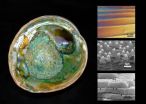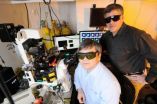(Press-News.org) In a sweeping review of the field of bio-inspired engineering and biomimicry in the Feb. 15 issue of the journal Science, two engineers at the University of California, San Diego, identify three characteristics of biological materials that they believe engineers would do well to emulate in man-made materials: light weight, toughness and strength.
Joanna McKittrick and Marc Meyers, from the materials science program at the Jacobs School of Engineering at UC San Diego, examine the three characteristics in a wide range of materials, from spider silk, to lobster and abalone shells, to toucan beaks and porcupine quills. Lessons learned from these materials could lead to better body armor, lighter aircraft and stronger, more flexible materials, researchers said.
3-D printing offers new opportunities to fabricate these materials, engineers said. "An abalone doesn't grow a shell overnight," McKittrick said. "But you could build a material similar to the abalone shell using principles we learned from nature by printing layer upon layer of mineral deposits—and do it much faster than nature would."
Meyers and McKittrick have been studying bio-inspired designs for more than a decade and were commissioned to write a research review on the topic by Science. Over the years, they have used a wide array of advanced tools, from
X-ray diffraction to electron microscopy; and developed tests of materials' mechanical properties at the nanoscale, to understand the underlying structure of materials found in animals and plants.
"Mother Nature gives us templates," said McKittrick. "We are trying to understand them better so we can implement them in new materials."
"We outline the mechanisms that can help us elucidate the properties of biological materials," Meyers said.
Bio-inspired designs have been a part of science and engineering for a long time—from the legend of Icarus, to Leonardo Da Vinci's flying machines, inspired by birds, to modern-day materials such as Velcro, Meyers pointed out.
Tough materials: the importance of interfaces
Tough materials deflect cracks by erecting various obstacles that prevent cracks from propagating in a straight line. Materials in nature use various strategies to achieve this result. One is to embed stretchy collagen fibers in brittle minerals. Another is the use of interfaces between layers of materials to create obstacles.
For example, at the nanoscale, an abalone shell is made of thousands of layers of "tiles" made of calcium carbonate (more commonly known as chalk), about 10 micrometers across and 0.5 micrometer thick—about one-one hundredth the thickness of a strand of human hair. The irregular stacks of thin tiles refract light to yield the characteristic luster of mother of pearl. They are organized in a highly ordered brick-like structure arranged in the toughest configuration theoretically possible.
A key to the strength of the abalone shell, Meyers said, is a protein adhesive that binds to the top and bottom surfaces of the calcium carbonate tiles. The glue is strong enough to hold layers of tiles firmly together, but weak enough to permit the layers to slip apart, absorbing the energy of a heavy blow in the process. Abalones quickly fill in fissures due to impacts, and they also deposit "growth bands" of organic material during seasonal lulls in shell growth. The growth bands further strengthen the shells. Meyers believes that designs inspired by the structure of the abalone shell could help improve advanced ceramic materials in the future.
Lightweight structures: shells and foams
Animals have developed incredibly light yet tough structures compatible with motion, including flight. Think of bird feathers, porcupine quills and bird beaks. These structures are made of materials that don't bend while being as light as possible. Most are made of tube-like structures with a fairly large diameter. But when the tubes' diameter reaches a certain size, they become increasingly likely to buckle. To increase resistance to buckling, the tubes are then filled with a foam-like substance.
For example, the interior of the toucan's beak is rigid "foam" made of bony fibers and drum-like membranes sandwiched between outer layers of keratin, the protein that makes up fingernails, hair and horn. The result is solid "foam" made of air-tight cells that gives the beak additional rigidity. Like a house covered by a shingled roof, the foam is covered with overlapping keratin tiles, each about 50 micrometers in diameter and 1 micrometer thick, which are glued together to produce sheets.
Meyers said the bio-composite found in the toucan's beak could inspire the design of ultra-light aircraft and vehicle components.
The researchers also describe other strategies to make lightweight objects. Some bird wing bones have strut-like structures inside them as reinforcements. Bamboo is made of segments that don't crack.
"Natural systems are built from so few elements, yet they use ingenious ways to assemble all these different materials to maximize their properties," McKittrick said.
Strong materials: the importance of biopolymers
Biopolymers, such as collagen, are a key component of strong natural materials. At lower stress levels, they can undergo considerable stretching, their molecules uncoiling and unkinking, without breaking. At higher stress levels, it's the polymer's backbone itself that stretches. These biopolymers are found between stiff minerals, giving materials their natural strength.
For example, spider silk has both high tensile strength and extensibility. "It's stronger than almost any material," Meyers said. The si¬lk is made of pleated sheets of nanocrystals connected by weak hydrogen bonds and embedded in protein strands. Under low stress, the protein strands uncoil and straighten, much like biopolymers. Under larger stress, the load gets transferred to the nanocrystals. If necessary, some of the hydrogen bonds slip, allowing the structure to stretch without breaking. Silk's reliance on hydrogen bonds for strength suggests that researchers may need to pursue new avenues to engineer stronger materials, Meyers said. Incidentally, similar structures can be found in bone, where sacrificial hydrogen bonds between mineralized collagen fibrils impart excellent fracture resistance.
More complex strong structures can be found in everything from wool to whelk eggs.
Real-life examples of bioinspired materials and design
Beyond Velcro, there are multiple examples of bio-inspired materials and design. Swimsuits for competitive swimmers were built to replicate the ridges that reduce drag on shark skin (and were later banned from competition). Researchers at MIT have developed a surgical tape based on the structure of the gecko's sticky paws. Irregularities found on whale fins reduce drag and are now used in turbine blade designs.
Researchers believe more, and better, materials are yet to come.
"There are a tremendous number of examples of things we can't do with traditional materials," McKittrick said. "It's going to take more time to make these bio-inspired materials. But they will be better."
"This field is here to stay," Meyers said.
INFORMATION:
Tough, light and strong: Lessons from nature could lead to the creation of new materials
2013-02-15
ELSE PRESS RELEASES FROM THIS DATE:
Clues to the mysterious origin of cosmic rays
2013-02-15
In the year 1006 a new star was seen in the southern skies and widely recorded around the world. It was many times brighter than the planet Venus and may even have rivaled the brightness of the Moon. It was so bright at maximum that it cast shadows and it was visible during the day. More recently astronomers have identified the site of this supernova and named it SN 1006. They have also found a glowing and expanding ring of material in the southern constellation of Lupus (The Wolf) that constitutes the remains of the vast explosion.
It has long been suspected that such ...
Slithering towards extinction
2013-02-15
NINETEEN PERCENT of the world's reptiles are estimated to be threatened with extinction, states a paper published today by the Zoological Society of London (ZSL) in conjunction with experts from the IUCN Species Survival Commission (SSC).
The study, printed in the journal of Biological Conservation, is the first of its kind summarising the global conservation status of reptiles. More than 200 world renowned experts assessed the extinction risk of 1,500 randomly selected reptiles from across the globe.
Out of the estimated 19% of reptiles threatened with extinction, ...
Losing hope of a good night's sleep is risk factor for suicide
2013-02-15
AUGUSTA, Ga. – When people lose hope that they will ever get another good night's sleep, they become at high risk for suicide, researchers report.
Insomnia and nightmares, which are often confused and may go hand-in-hand, are known risk factors for suicide but just how they contribute was unknown, said Dr. W. Vaughn McCall, Chair of the Medical College of Georgia Department of Psychiatry and Health Behavior at Georgia Regents University.
The new study reaffirms that link and adds the element of hopelessness about sleep that is independent of other types of hopelessness, ...
Climate scientist Schellnhuber to brief UN Security Council
2013-02-15
It will take place on February 15th at the UN headquarters in New York City. Secretary-General Ban Ki-moon plans to attend.
"With unabated greenhouse-gas emissions, humankind would venture into an uncertain future that is much hotter than ever before in its history – so from a scientist's perspective, climate change is a global risk multiplier," says Schellnhuber, director of PIK and chair of the Scientific Advisory Council on Global Change (WBGU) for the German government. Many millions of people could be affected by severe climate change impacts. They range from sea-level ...
Math helps detect gang-related crime and better allocate police resources
2013-02-15
Philadelphia, PA—Social groups in a population can lend important cues to law enforcement officials, consumer-based services and risk assessors. Social and geographical patterns that provide information about such communities or gangs have been a popular subject for mathematical modeling.
In a paper published last month in the SIAM Journal on Applied Mathematics, authors use police department records about individuals' social and geographical information to determine gang memberships.
Data on social interactions is particularly hard to come by, but in combination ...
Yale study links common chemicals to osteoarthritis
2013-02-15
New Haven, Conn. – A new study has linked exposure to two common perfluorinated chemicals (PFCs) with osteoarthritis. PFCs are used in more than 200 industrial processes and consumer products including certain stain- and water-resistant fabrics, grease-proof paper food containers, personal care products, and other items. Because of their persistence, PFCs have become ubiquitous contaminants of humans and wildlife. The study, published in Environmental Health Perspectives, is the first to look at the associations between perfluorooctanoic acid (PFOA) and perfluorooctanesulfonic ...
Why cells stick: Phenomenon extends longevity of bonds between cells
2013-02-15
Research carried out by scientists at the Georgia Institute of Technology and The University of Manchester has revealed new insights into how cells stick to each other and to other bodily structures, an essential function in the formation of tissue structures and organs. It's thought that abnormalities in their ability to do so play an important role in a broad range of disorders, including cardiovascular disease and cancer.
The study's findings are outlined in the journal Molecular Cell and describe a surprising new aspect of cell adhesion involving the family of cell ...
Researchers invent 'acoustic-assisted' magnetic information storage
2013-02-15
CORVALLIS, Ore. – Electrical engineers at Oregon State University have discovered a way to use high- frequency sound waves to enhance the magnetic storage of data, offering a new approach to improve the data storage capabilities of a multitude of electronic devices around the world.
The technology, called acoustic-assisted magnetic recording, has been presented at a professional conference, and a patent application was filed this week.
Magnetic storage of data is one of the most inexpensive and widespread technologies known, found in everything from computer hard drives ...
Leading RSV researcher publishes work at Le Bonheur Children's
2013-02-15
Memphis, Tenn. – Studies at Le Bonheur Children's Hospital in Memphis, Tenn., are advancing our understanding of how viruses, including RSV, replicate in humans, mutate to avoid the immune response and can be effectively treated.
John DeVincenzo, MD, medical director of Molecular Diagnostics and Virology Laboratories at Le Bonheur, and professor of Pediatrics and Microbiology, Immunology, and Molecular Biology at The University of Tennessee Health Science Center, has recently published three papers on this topic. DeVincenzo's lab is one of only two of its kind in the ...
Revealing the secrets of motility in archaea
2013-02-15
The protein structure of the motor that propels archaea has been characterized for the first time by a team of scientists from the U.S. Department of Energy's Lawrence Berkeley National Laboratory (Berkeley Lab) and Germany's Max Planck Institute (MPI) for Terrestrial Microbiology.
The motility structure of this third domain of life has long been called a flagellum, a whip-like filament that, like the well-studied bacterial flagellum, rotates like a propeller. But although the archaeal structure has a similar function, it is so profoundly different in structure, genetics, ...




